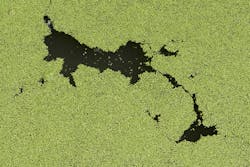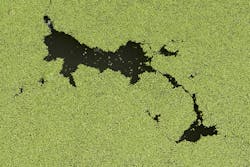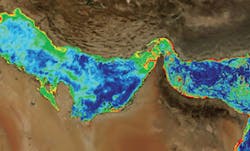Overcoming Algal Attacks: How Desalination Plants Can Beat The Blooms
How desalination plants can beat the blooms
Harmful algal blooms are increasing in frequency and severity. With a lack of collective knowledge on the topic across multiple industry disciplines, a practical guide has been published for desalination plant operators on how to monitor, manage and prevent the impact of harmful algal blooms. This article takes a look at some of the key findings.
By Siobhan Boerlage, Mike Dixon and Don Anderson
In areas prone to algal blooms, algae have long been an issue impacting desalination plant operation. This is particularly the case where macroalgae (seaweeds) and detritus can become dislodged from the seabed. Blooms or more accurately harmful algal blooms (HABs) of microscopic algal species (phytoplankton) are particularly challenging in seawater water reverse osmosis (SWRO).
HABs are broadly classed as toxic or non-toxic and pose two main operational risks in desalination. Marine algal toxins may be produced by toxic blooms such as those caused by Alexandrium, Pyrodinium, and Gymnodinium species that release the neurotoxin saxitoxin.
If they are present in sufficiently high concentrations in the seawater and they break through the desalination process, HABs represent a potential health risk to the safety of desalinated drinking water. Non-toxic blooms can increase the suspended solids and organic load in seawater beyond design thresholds in high biomass blooms - threatening water supply security through unplanned outages and loss of productionThis may manifest at any point in the process from blinding of intakes (rare) through to overloading of pre-treatment unit processes and/or failure of the SWRO system itself. Should pre-treatment fail to produce water to meet RO guidelines, plants may be forced to void warranties and continue operating or shut down to avoid the risk of irreversible RO membrane fouling through accelerated (bio)fouling. In the latter case, they may also incur cost penalties associated with loss of production.
Plant shutdown
When blooms are infrequent or of short duration, operators and designers may elect to turn down production or shut down SWRO plants, if contract obligations allow. In areas subject to frequent and prolonged blooms and high plant availability is required, additional pre-treatment such as dissolved air flotation (DAF), began to be employed as early as 1995.
The prolonged and extensive 2008/2009 bloom of the non-toxic Cochlodinium polykrikoides in the Gulf of Oman and the broader Gulf region was unprecedented in the industry and led to massive impacts.
SWRO plant shutdowns lasted as long as four months as conventional pre-treatment processes, based on ferric chloride coagulation and single stage dual media filtration (DMF), struggled to remove the increased biomass and produce the required RO feedwater quality. One plant reported 100 percent RO membrane replacement due to severe biofouling. Meanwhile, thermal desalination plants in the region generally continued to operate without major issue throughout the bloom. The phytoplankton blooms can pass through intake screens and thermal processes are very forgiving of source water quality.
Globally, HABs similar to the 2008 Cochlodinium polykrikoides bloom are increasing in frequency and severity. Impacts of HABs on desalination facilities are thus a significant and growing problem, made worse by the lack of knowledge of this phenomenon among plant operators, managers, engineers, and others involved in the industry, including regulatory agencies.
Recognising this problem, the Middle East Desalination Research Center (MEDRC) and the UNESCO Intergovernmental Oceanographic Commission (IOC) organised a series of conferences in 2012 and 2014 in Muscat, Oman, to bring HAB researchers and desalination professionals together to exchange knowledge and discuss the scale of the problem.
Recommendations from these meetings included the preparation of a “guidance manual” to provide information to desalination plant operators and others in the industry about marine HABs, their impacts, and the strategies that could be used to mitigate those impacts. With support from the US Agency for International Development (USAID) and the IOC Intergovernmental Panel for Harmful Algal Blooms (IPHAB), an editorial team (Don Anderson, Siobhan Boerlage and Mike Dixon) was assembled in 2015. Three years of extensive consultation and collaboration with numerous HAB and desalination industry specialists from several disciplines culminated in the publication of “Harmful Algal Blooms (HABs) and Desalination: A Guide to Impacts, Monitoring, and Management”.
A need for data
One of the conclusions from the manual was that HAB issues are far more significant for SWRO plants than for those that use thermal desalination. Both types of processes are very effective in removing HAB toxins. However, SWRO plants are extremely vulnerable to feedwater quality and far more susceptible to clogging of pre-treatment granular media filters and fouling of pre-treatment and RO membranes by algal-derived material (AOM) and particulate biomass. Accordingly, the focus of the Manual was on SWRO, with only occasional reference to thermal processes.
The first chapter provides a broad overview of HAB phenomena, including their impacts, the spatial and temporal nature of their blooms, common causative species, trends in occurrence, and general aspects of bloom dynamics in coastal waters.
AOM components which have been identified as playing a role in membrane fouling such as high molecular weight biopolymers (polysaccharides and proteins), which include sticky transparent exopolymer particles (TEP) and their mechanisms in promoting fouling are also explained in detail.
Currently, most desalination plants do not collect data on seawater outside their plants, so they are generally unaware of the presence (now or anticipated) of a potentially disruptive HAB. Therefore, practical information is provided on the approaches to implementing an observing system for HABs. This describes sampling methods and measurement options that can be tailored to available resources and the nature of the HAB threat in a given area.
All are based on direct water sampling, but it is also possible to observe HABs from space – particularly the high biomass events. Satellite remote sensing can be used for early warning and to reveal the spatial extent and transport of blooms. Figure 1 shows a graphic example of the incredible scale and resolution of this observational approach.
Seawater intake
The first point of control in minimising the entrainment of algae into the plant is the seawater intake. The document addresses the efficiency of deep water open intakes and subsurface intakes in mitigating the ingress of algal cells and NOM (natural organic matter) components, which include extracellular or intracellular TEP produced during an algal bloom.
One question asked frequently by HAB scientists is whether the blooms can be controlled or suppressed in a manner analogous to the treatment of insects or other agricultural pests on land. This has proven to be an exceedingly difficult challenge for the HAB scientific and management community, given the dynamic nature of HABs in coastal waters, their large spatial extent, and concerns about the environmental impacts of bloom control methods. A summary of the approaches to bloom prevention and control that have been developed is provided in the manual, as well as a discussion on whether these are feasible or realistic in the context of an individual desalination plant.
In line with recommendations from the World Health Organization, a chapter describing risk assessment frameworks e.g. Hazard Analysis and Critical Control Point and the multi-barrier approach that can be used to assure safe drinking water in the face of a toxic marine HAB, along with HAB Management Response Plans is included. A subsequent chapter then examines toxin removal during SWRO pre-treatment and RO and thermal desalination.
Chapter 9 presents many of the RO pre-treatment strategies and discusses their use in removing AOM and particulates to prevent filter clogging and membrane fouling. This is necessary to maintain effective plant operation and avoid serious operational challenges for the RO. The chapter covers common pre-treatments such as chlorination/dechlorination, coagulation, dissolved air flotation, granular media filtration, ultrafiltration, and cartridge filtration, in addition to discussing issues experienced due to the inefficiencies of each pretreatment on reverse osmosis.
Case studies
A series of case studies from the desalination industry describing individual HAB events characteristic of various feedwaters around the world is provided to showcase practical experience in dealing with these events. Algal blooms, primarily phytoplankton, were reported in almost all geographic locations, in cold and warm seas over a range of salinities affecting municipal and industrial desalination plants.
Notable areas affected include the warmer waters of the Gulf and Gulf of Oman in the Middle East. Case studies include Sohar and Barka 1 in Oman, Fujairah 2 in UAE and the Shuwaikh plant located close to Kuwait’s most important commercial port in the upper reaches of the Gulf where seawater quality is at its poorest. HABs are also commonly found in the cooler waters off the coast of Antofagasta in Chile supplying industry and drinking water for towns in one of the driest areas of the world.
The types of impacts and the strategies that were used to combat them are detailed in each case study. Strategies included measures adopted during design and/or during plant operation e.g. deep water intakes (Gold Coast), and DAF and/or direct MF/UF filtration (Jacobahaven, Sohar) or subsequently enacted in response to HAB events (La Chimba). The main focus of the case studies was selection and design of pre-treatment and covered pilot and full-scale SWRO plants with conventional and advanced MF/UF membrane pre-treatment. The latter was the predominant pre-treatment choice in the case studies involving a variety of membrane materials and pore sizes either in the pressurised inside-out or outside-in flow configuration
The twelve case studies present an array of options for operating in algal-rich seawater. Mitigation measures implemented to maintain plant production confirmed many of our industry’s perceptions for HAB treatment. For example:
• Careful, informed site analysis with a focus on the potential for different types of algal blooms can be a cost-effective strategy that minimises future pretreatment needs
• Long-term monitoring programs to characterise seawater quality should be conducted at the plant intake site. This should include a review of historical records examining the frequency and severity of algal blooms (if available)
• Piloting at site is recommended with challenge testing using cultivated algae if no blooms occur
• Conventional parameters such as the SDI have proven useful in detecting blooms at an intake. Care needs to be taken with the SDI as it will underestimate the fouling potential of feedwater, especially during algal blooms
• Parameters have been developed to monitor AOM constituents and the increase in (bio)fouling potential of seawater during a bloom e.g. biopolymer concentration by LC-OCD, TEP10kDa, MFI-UF using a 10 kDa test membrane and the AOC luminescence test using Vibrio harveyi. These tests can be used to assess and optimise pre-treatment during a bloom. While promising, the degree of difficulty and cost in determining them is correspondingly higher. As yet, these parameters cannot be employed to alert a plant to a bloom or to adjust process parameters during plant operation
• Deep-water open ocean intakes may be successful in avoiding some bloom-forming species as shown at the Gold Coast Plant, but some species are motile or display diel vertical migration so that they move 10m or more daily within the water column. Moreover, the distribution of AOM may not reflect the distribution of algal cells in the water column. Deep water intakes are thus not guaranteed to prevent the ingress of algae and AOM into a plant
• Avoiding chlorination-dechlorination during a bloom will help to prevent downstream fouling as fouling AOM will be retained intercellularly along with toxins and less assimilable organic carbon is generated through oxidation of organic matter
• Coagulation is important for all three pre-treatments (DAF, UF, and DMF) and acts to remove AOM more effectively than these pre-treatment processes alone. Less AOM in the pretreated water will help to alleviate SWRO fouling
• Coagulation, albeit at a lower dose than for DMF, is therefore practiced in UF to remove dissolved AOM, improve removal of biopolymers and TEP, and the filterability of the cake deposited on UF membranes
• DAF is a good choice for cell removal in areas predicted to experience heavy blooms, as it removes cells by floatation, minimising cell rupture
• UF plants can continue operations during an algal bloom if operating techniques are used to prevent hydraulically irreversible fouling. The following techniques were used in the 12 case studies: reducing flux (four plants), recirculating flow (one plant), use of coagulation involving optimizing the dose or switching on coagulation in response to blooms (three plants), decreasing backwashing intervals (two plants), increased CEB frequency (five plants) and CIP (three plants).
• DMF or UF alone can accomplish cell removal and some dissolved AOM (if coagulation is used for UF) for light algal blooms, but using a DAF upstream is prudent for heavy blooms . The combination of DAF and UF is increasingly being applied in the industry, when applied in bypass mode, care needs to be taken to bring the DAF online in time.
In conclusion, the compilation of this manual was a major undertaking, requiring the cooperation of scientists and engineers from multiple disciplines, including a number where interactions have been rare in the past. This document will be updated through time and readily available through the internet.
Figure 1. Chlorophyll concentrations captured by the MODIS Aqua sensor (NASA) from February 6, 2016, showing typical bloom patterns for the Arabian Gulf, Sea of Oman region, with low chlorophyll (dark blue) away from the coasts and high chlorophyll (orange and red) in complex patches and filaments, particularly around the Arabian Peninsula. The patterns are caused by surface transport and concentration of a harmful Cochlodinium bloom that is widely dispersed in response to surface currents and eddies. (Courtesy of R. Kudela, University of California, Santa Cruz and the National Aeronautics and Space Administration (NASA).
Siobhan Boerlage, Mike Dixon and Don Anderson co-authored the manual, which is available online for download at www.ioc-unesco.org/desalination-HAB. Please contact Henrik Enevoldsen ([email protected]) to request a printed copy of the publication.


